Q11.1
Write IUPAC names of the following compounds:
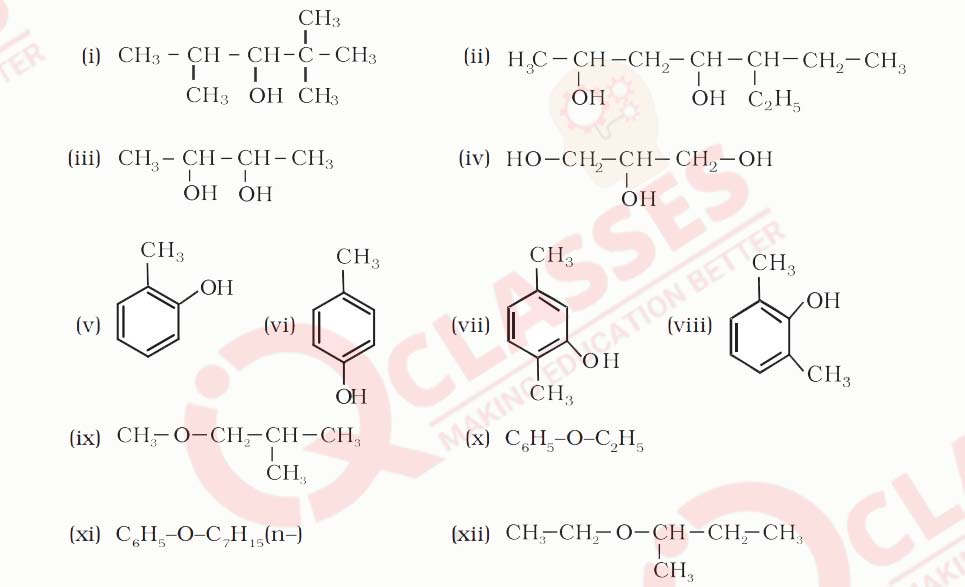 Solution
Solution


 Solution
Solution


Q11.2
Write structures of the compounds whose IUPAC names are as follows:
(i) 2-Methylbutan-2-ol
(ii) 1-Phenylpropan-2-ol
(iii) 3,5-Dimethylhexane –1, 3, 5-triol
(iv) 2,3 – Diethylphenol
(v) 1 – Ethoxypropane
(vi) 2-Ethoxy-3-methylpentane
(vii) Cyclohexylmethanol
(viii) 3-Cyclohexylpentan-3-ol
(ix) Cyclopent-3-en-1-ol
(x) 4-Chloro-3-ethylbutan-1-ol.
Solution


(i) 2-Methylbutan-2-ol
(ii) 1-Phenylpropan-2-ol
(iii) 3,5-Dimethylhexane –1, 3, 5-triol
(iv) 2,3 – Diethylphenol
(v) 1 – Ethoxypropane
(vi) 2-Ethoxy-3-methylpentane
(vii) Cyclohexylmethanol
(viii) 3-Cyclohexylpentan-3-ol
(ix) Cyclopent-3-en-1-ol
(x) 4-Chloro-3-ethylbutan-1-ol.
Solution



Q11.3
(i) Draw the structures of all isomeric alcohols of molecular formula C5H12O
and give their IUPAC names.
(ii) Classify the isomers of alcohols in question 11.3 (i) as primary, secondary and tertiary alcohols.
Solution

(ii) Classify the isomers of alcohols in question 11.3 (i) as primary, secondary and tertiary alcohols.
Solution


Q11.4
Explain why propanol has higher boiling point than that of the hydrocarbon,
butane?
Solution


Q11.5
Alcohols are comparatively more soluble in water than hydrocarbons of
comparable molecular masses. Explain this fact.s Mention the factors that affect the rate of a chemical
reaction
Solution


Q11.6
What is meant by hydroboration-oxidation reaction? Illustrate it with an example.
Solution




Q11.7
Give the structures and IUPAC names of monohydric phenols of molecular
formula, C7H8O.
Solution


Q11.8
While separating a mixture of ortho and para nitrophenols by steam
distillation, name the isomer which will be steam volatile. Give reason.
Solution


Q11.9
Give the equations of reactions for the preparation of phenol from cumene
Solution




Q11.10
Write chemical reaction for the preparation of phenol from chlorobenzene
Solution


Q11.11
Write the mechanism of hydration of ethene to yield ethanol.
Solution




Q11.12
You are given benzene, conc. H2SO4 and NaOH. Write the equations for the
preparation of phenol using these reagents.
Solution


Q11.13
Show how will you synthesise:
(i) 1-phenylethanol from a suitable alkene. (ii) cyclohexylmethanol using an alkyl halide by an SN2 reaction.
(iii) pentan-1-ol using a suitable alkyl halide?
Solution

(i) 1-phenylethanol from a suitable alkene. (ii) cyclohexylmethanol using an alkyl halide by an SN2 reaction.
(iii) pentan-1-ol using a suitable alkyl halide?
Solution


Q11.14
Give two reactions that show the acidic nature of phenol. Compare acidity
of phenol with that of ethanol.
Solution




Q11.15
Explain why is ortho nitrophenol more acidic than ortho methoxyphenol ?
Solution


Q11.16
Explain how does the –OH group attached to a carbon of benzene ring
activate it towards electrophilic substitution?
Solution


Q11.17
Give equations of the following reactions:
(i) Oxidation of propan-1-ol with alkaline KMnO4 solution.
(ii) Bromine in CS2 with phenol.
(iii) Dilute HNO3 with phenol.
(iv) Treating phenol wih chloroform in presence of aqueous NaOH
Solution

(i) Oxidation of propan-1-ol with alkaline KMnO4 solution.
(ii) Bromine in CS2 with phenol.
(iii) Dilute HNO3 with phenol.
(iv) Treating phenol wih chloroform in presence of aqueous NaOH
Solution


Q11.18
Explain the following with an example.
(i) Kolbe’s reaction.
(ii) Reimer-Tiemann reaction.
(iii) Williamson ether synthesis.
(iv) Unsymmetrical ether Solution


(i) Kolbe’s reaction.
(ii) Reimer-Tiemann reaction.
(iii) Williamson ether synthesis.
(iv) Unsymmetrical ether Solution



Q11.19
Write the mechanism of acid dehydration of ethanol to yield ethene.
Solution




Q11.20
How are the following conversions carried out?
(i) Propene → Propan-2-ol.
(ii) Benzyl chloride → Benzyl alcohol.
(iii) Ethyl magnesium chloride → Propan-1-ol.
(iv) Methyl magnesium bromide → 2-Methylpropan-2-ol.
Solution


(i) Propene → Propan-2-ol.
(ii) Benzyl chloride → Benzyl alcohol.
(iii) Ethyl magnesium chloride → Propan-1-ol.
(iv) Methyl magnesium bromide → 2-Methylpropan-2-ol.
Solution



Q11.21
Name the reagents used in the following reactions:
(i) Oxidation of a primary alcohol to carboxylic acid.
(ii) Oxidation of a primary alcohol to aldehyde.
(iii) Bromination of phenol to 2,4,6-tribromophenol.
(iv) Benzyl alcohol to benzoic acid.
(v) Dehydration of propan-2-ol to propene.
(vi) Butan-2-one to butan-2-ol.
Solution
(i) Oxidation of a primary alcohol to carboxylic acid.
(ii) Oxidation of a primary alcohol to aldehyde.
(iii) Bromination of phenol to 2,4,6-tribromophenol.
(iv) Benzyl alcohol to benzoic acid.
(v) Dehydration of propan-2-ol to propene.
(vi) Butan-2-one to butan-2-ol.
Solution

Q11.22
Give reason for the higher boiling point of ethanol in comparison to
methoxymethane.
Solution


Q11.23
Give IUPAC names of the following ethers:
 Solution
Solution

 Solution
Solution

Q11.24
Write the names of reagents and equations for the preparation of the following
ethers by Williamson’s synthesis:
(i) 1-Propoxypropane
(ii) Ethoxybenzene
(iii) 2-Methoxy-2-methylpropane
(iv) 1-Methoxyethane
Solution
(i) 1-Propoxypropane
(ii) Ethoxybenzene
(iii) 2-Methoxy-2-methylpropane
(iv) 1-Methoxyethane
Solution

Q11.25
Illustrate with examples the limitations of Williamson synthesis for the
preparation of certain types of ethers.
Solution




Q11.26
How is 1-propoxypropane synthesised from propan-1-ol? Write mechanism
of this reaction.
Solution

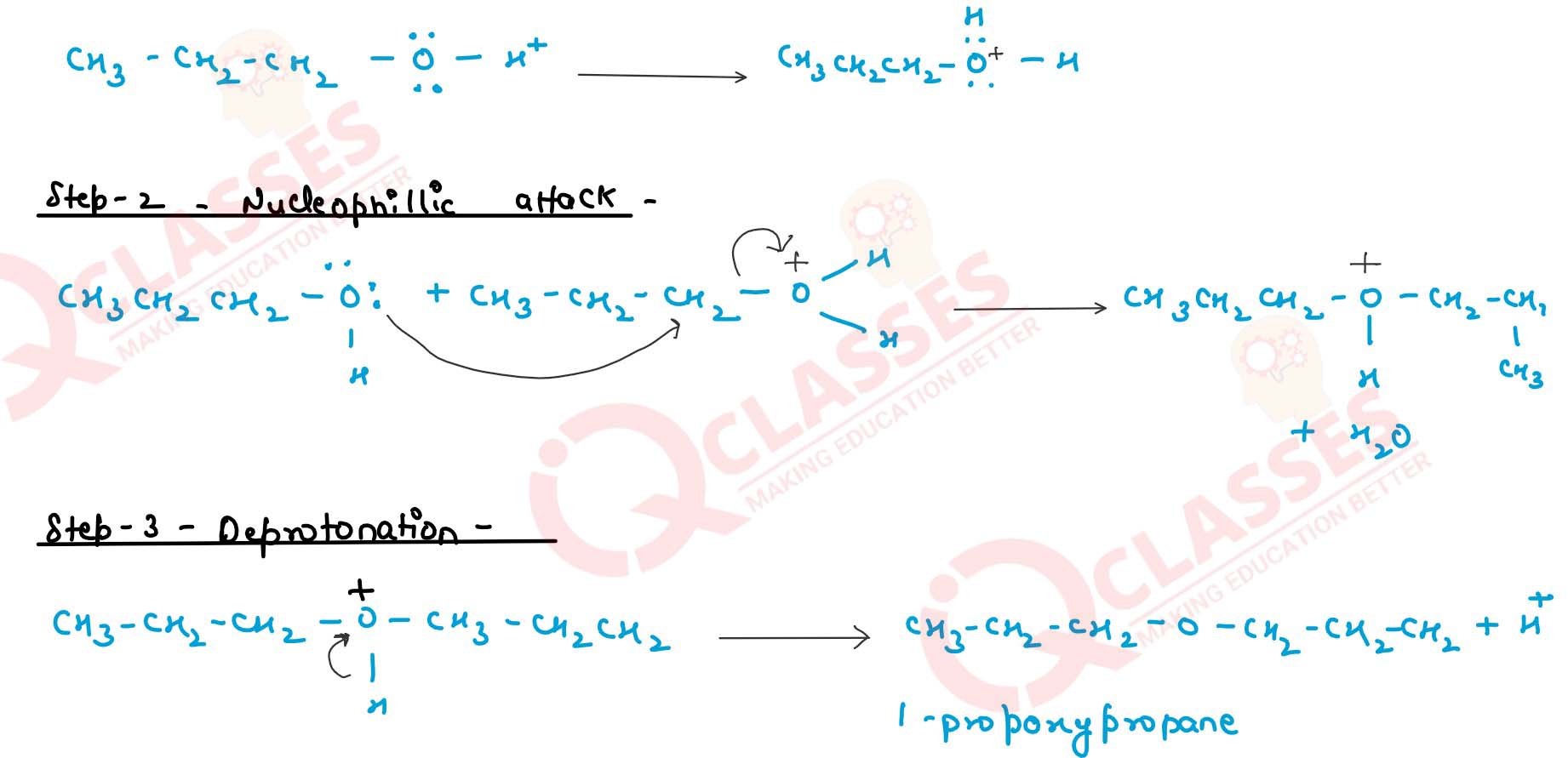


Q11.27
Preparation of ethers by acid dehydration of secondary or tertiary alcohols
is not a suitable method. Give reason
Solution


Q11.28
Write the equation of the reaction of hydrogen iodide with:
(i) 1-propoxypropane (ii) methoxybenzene and (iii) benzyl ethyl ether. Solution

(i) 1-propoxypropane (ii) methoxybenzene and (iii) benzyl ethyl ether. Solution


Q11.29
Explain the fact that in aryl alkyl ethers (i) the alkoxy group activates the
benzene ring towards electrophilic substitution and (ii) it directs the
incoming substituents to ortho and para positions in benzene ring.
Solution




Q11.30
Write the mechanism of the reaction of HI with methoxymethane.
Solution






Q11.31
Write equations of the following reactions:
(i) Friedel-Crafts reaction – alkylation of anisole.
(ii) Nitration of anisole.
(iii) Bromination of anisole in ethanoic acid medium.
(iv) Friedel-Craft’s acetylation of anisole.
Solution
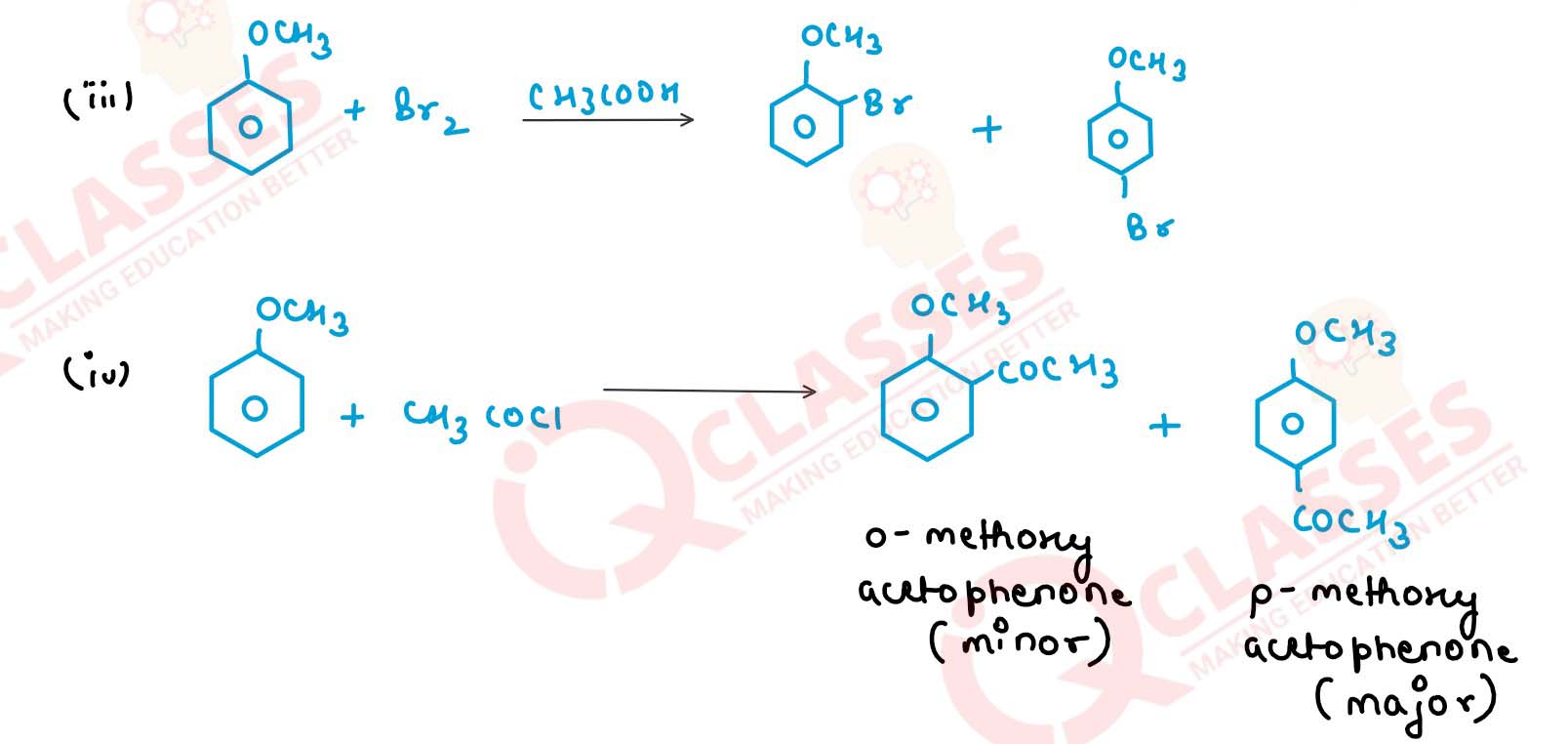
(i) Friedel-Crafts reaction – alkylation of anisole.
(ii) Nitration of anisole.
(iii) Bromination of anisole in ethanoic acid medium.
(iv) Friedel-Craft’s acetylation of anisole.
Solution


Q11.32
Show how would you synthesise the following alcohols from appropriate
alkenes?
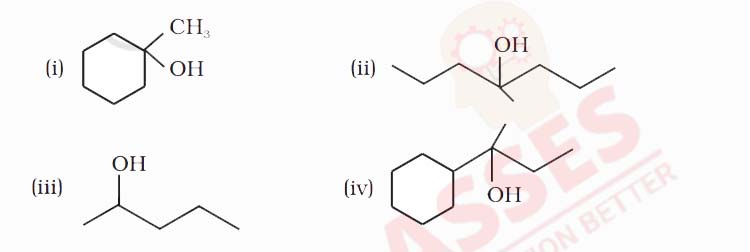 Solution
Solution

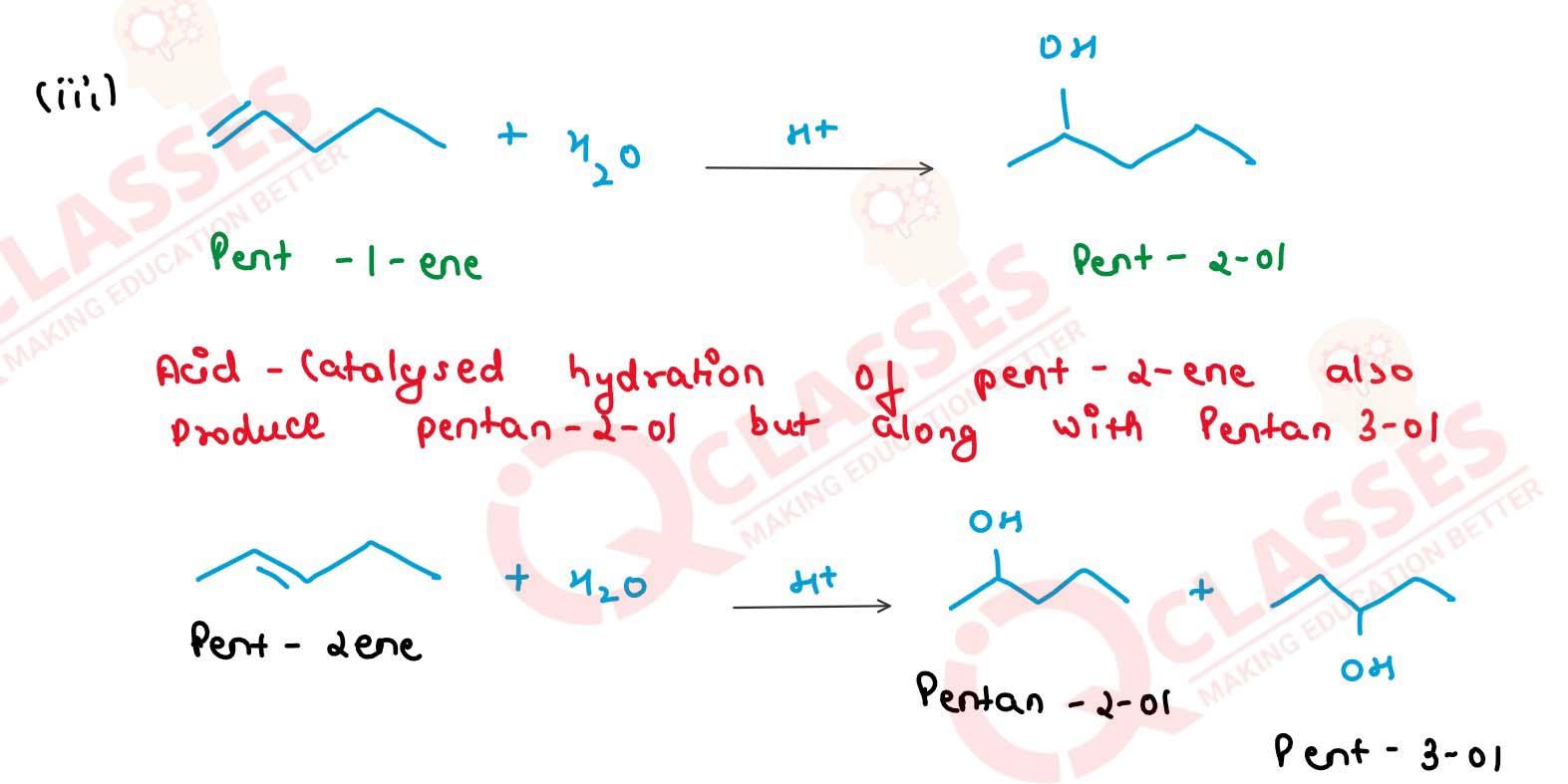

 Solution
Solution



Q11.33
When 3-methylbutan-2-ol is treated with HBr, the following reaction takes
place:
 Solution
Solution

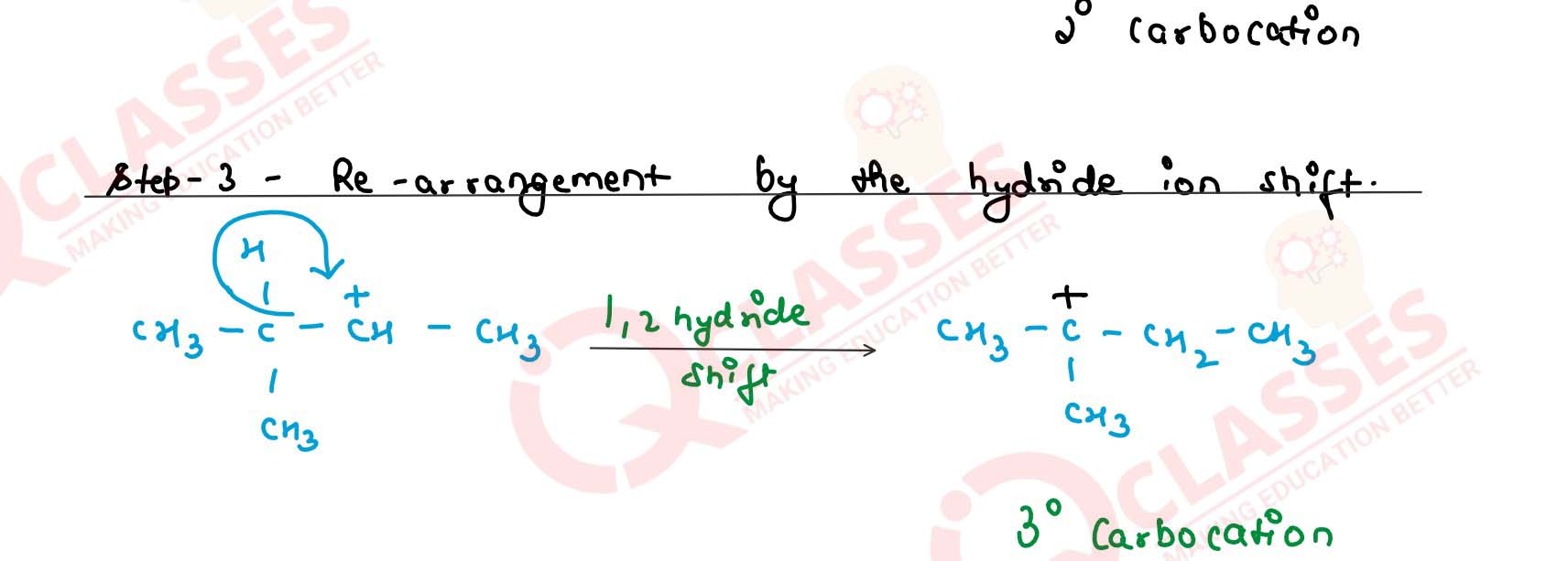

 Solution
Solution


